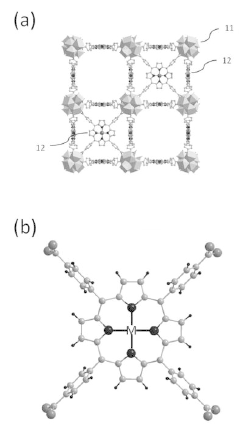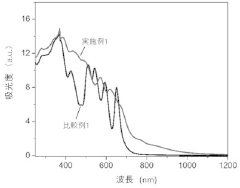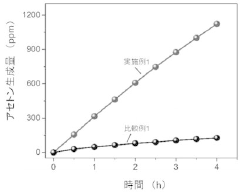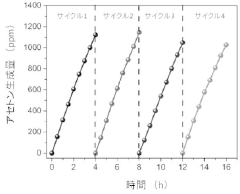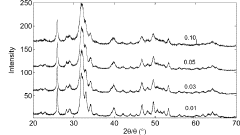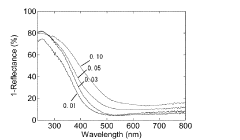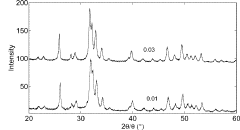Examining Hydroxyapatite-Metalloporphyrin Complexes for Photocatalyst Efficiency
JUL 23, 202510 MIN READ
Generate Your Research Report Instantly with AI Agent
Patsnap Eureka helps you evaluate technical feasibility & market potential.
Hydroxyapatite-Metalloporphyrin Photocatalysis Overview
Hydroxyapatite-metalloporphyrin complexes have emerged as promising materials for photocatalytic applications, combining the unique properties of both components to enhance overall efficiency. Hydroxyapatite, a calcium phosphate mineral, serves as an excellent support material due to its biocompatibility, stability, and high surface area. Metalloporphyrins, on the other hand, are synthetic analogues of natural light-harvesting complexes, capable of efficiently absorbing light and facilitating electron transfer processes.
The integration of metalloporphyrins with hydroxyapatite creates a synergistic system that addresses several challenges in photocatalysis. The porous structure of hydroxyapatite provides a large surface area for the immobilization of metalloporphyrin molecules, preventing their aggregation and enhancing their photocatalytic activity. Additionally, the hydroxyapatite support can improve the stability of the metalloporphyrins, protecting them from degradation during prolonged photocatalytic reactions.
Recent studies have demonstrated the potential of hydroxyapatite-metalloporphyrin complexes in various photocatalytic applications, including water splitting, CO2 reduction, and organic pollutant degradation. The choice of metal center in the porphyrin structure plays a crucial role in determining the specific catalytic properties of the complex. For instance, iron and cobalt porphyrins have shown promising results in CO2 reduction, while zinc and manganese porphyrins have exhibited excellent performance in organic pollutant degradation.
One of the key advantages of these complexes is their tunable nature. By modifying the metalloporphyrin structure or the composition of the hydroxyapatite support, researchers can tailor the photocatalytic properties to suit specific applications. This flexibility allows for the development of highly efficient and selective photocatalysts for a wide range of reactions.
Despite the promising results, challenges remain in optimizing the performance of hydroxyapatite-metalloporphyrin photocatalysts. These include improving the light absorption range, enhancing charge separation and transfer, and increasing the overall quantum efficiency of the system. Ongoing research efforts are focused on addressing these challenges through strategies such as doping the hydroxyapatite support, incorporating co-catalysts, and designing novel porphyrin structures.
As the field of photocatalysis continues to evolve, hydroxyapatite-metalloporphyrin complexes are poised to play a significant role in the development of next-generation photocatalysts. Their unique combination of properties, coupled with the potential for further optimization, makes them attractive candidates for addressing global challenges in energy production and environmental remediation.
The integration of metalloporphyrins with hydroxyapatite creates a synergistic system that addresses several challenges in photocatalysis. The porous structure of hydroxyapatite provides a large surface area for the immobilization of metalloporphyrin molecules, preventing their aggregation and enhancing their photocatalytic activity. Additionally, the hydroxyapatite support can improve the stability of the metalloporphyrins, protecting them from degradation during prolonged photocatalytic reactions.
Recent studies have demonstrated the potential of hydroxyapatite-metalloporphyrin complexes in various photocatalytic applications, including water splitting, CO2 reduction, and organic pollutant degradation. The choice of metal center in the porphyrin structure plays a crucial role in determining the specific catalytic properties of the complex. For instance, iron and cobalt porphyrins have shown promising results in CO2 reduction, while zinc and manganese porphyrins have exhibited excellent performance in organic pollutant degradation.
One of the key advantages of these complexes is their tunable nature. By modifying the metalloporphyrin structure or the composition of the hydroxyapatite support, researchers can tailor the photocatalytic properties to suit specific applications. This flexibility allows for the development of highly efficient and selective photocatalysts for a wide range of reactions.
Despite the promising results, challenges remain in optimizing the performance of hydroxyapatite-metalloporphyrin photocatalysts. These include improving the light absorption range, enhancing charge separation and transfer, and increasing the overall quantum efficiency of the system. Ongoing research efforts are focused on addressing these challenges through strategies such as doping the hydroxyapatite support, incorporating co-catalysts, and designing novel porphyrin structures.
As the field of photocatalysis continues to evolve, hydroxyapatite-metalloporphyrin complexes are poised to play a significant role in the development of next-generation photocatalysts. Their unique combination of properties, coupled with the potential for further optimization, makes them attractive candidates for addressing global challenges in energy production and environmental remediation.
Market Demand for Efficient Photocatalysts
The market demand for efficient photocatalysts has been steadily growing in recent years, driven by increasing environmental concerns and the need for sustainable energy solutions. Photocatalysts, particularly those based on hydroxyapatite-metalloporphyrin complexes, have garnered significant attention due to their potential applications in water treatment, air purification, and renewable energy production.
In the water treatment sector, there is a pressing need for advanced technologies to address the growing global water crisis. Efficient photocatalysts offer a promising solution for the degradation of organic pollutants and the removal of harmful contaminants from water sources. The market for water treatment technologies is projected to expand rapidly, with a particular focus on eco-friendly and energy-efficient solutions.
Air purification represents another key area of demand for efficient photocatalysts. With increasing urbanization and industrialization, air quality has become a major concern in many parts of the world. Photocatalytic materials capable of breaking down air pollutants and volatile organic compounds (VOCs) are highly sought after for both indoor and outdoor applications. This market segment is expected to see substantial growth, especially in densely populated urban areas and regions with high levels of industrial activity.
The renewable energy sector also presents significant opportunities for efficient photocatalysts. As the world transitions towards cleaner energy sources, there is a growing interest in artificial photosynthesis and solar fuel production. Hydroxyapatite-metalloporphyrin complexes show promise in this field, potentially enabling more efficient conversion of solar energy into chemical fuels.
Furthermore, the pharmaceutical and chemical industries are exploring the use of efficient photocatalysts for green chemistry applications. These catalysts can facilitate more environmentally friendly synthesis processes, reducing waste and energy consumption in chemical manufacturing. This aligns with the broader trend towards sustainable industrial practices and circular economy principles.
The automotive industry is another potential market for efficient photocatalysts, with applications in self-cleaning surfaces and air purification systems for vehicle interiors. As consumer awareness of air quality issues grows, demand for such technologies in personal and public transportation is likely to increase.
Overall, the market for efficient photocatalysts, including hydroxyapatite-metalloporphyrin complexes, is poised for significant expansion across multiple sectors. The combination of environmental pressures, regulatory initiatives, and technological advancements is creating a favorable landscape for the adoption of these materials. However, to fully capitalize on this market potential, ongoing research and development efforts are crucial to enhance the efficiency, stability, and cost-effectiveness of these photocatalytic systems.
In the water treatment sector, there is a pressing need for advanced technologies to address the growing global water crisis. Efficient photocatalysts offer a promising solution for the degradation of organic pollutants and the removal of harmful contaminants from water sources. The market for water treatment technologies is projected to expand rapidly, with a particular focus on eco-friendly and energy-efficient solutions.
Air purification represents another key area of demand for efficient photocatalysts. With increasing urbanization and industrialization, air quality has become a major concern in many parts of the world. Photocatalytic materials capable of breaking down air pollutants and volatile organic compounds (VOCs) are highly sought after for both indoor and outdoor applications. This market segment is expected to see substantial growth, especially in densely populated urban areas and regions with high levels of industrial activity.
The renewable energy sector also presents significant opportunities for efficient photocatalysts. As the world transitions towards cleaner energy sources, there is a growing interest in artificial photosynthesis and solar fuel production. Hydroxyapatite-metalloporphyrin complexes show promise in this field, potentially enabling more efficient conversion of solar energy into chemical fuels.
Furthermore, the pharmaceutical and chemical industries are exploring the use of efficient photocatalysts for green chemistry applications. These catalysts can facilitate more environmentally friendly synthesis processes, reducing waste and energy consumption in chemical manufacturing. This aligns with the broader trend towards sustainable industrial practices and circular economy principles.
The automotive industry is another potential market for efficient photocatalysts, with applications in self-cleaning surfaces and air purification systems for vehicle interiors. As consumer awareness of air quality issues grows, demand for such technologies in personal and public transportation is likely to increase.
Overall, the market for efficient photocatalysts, including hydroxyapatite-metalloporphyrin complexes, is poised for significant expansion across multiple sectors. The combination of environmental pressures, regulatory initiatives, and technological advancements is creating a favorable landscape for the adoption of these materials. However, to fully capitalize on this market potential, ongoing research and development efforts are crucial to enhance the efficiency, stability, and cost-effectiveness of these photocatalytic systems.
Current Challenges in Photocatalyst Development
The development of efficient photocatalysts faces several significant challenges that hinder their widespread application and commercial viability. One of the primary obstacles is the limited light absorption range of many photocatalysts. Most traditional photocatalysts, such as titanium dioxide (TiO2), can only utilize ultraviolet light, which accounts for a small fraction of the solar spectrum. This limitation severely restricts their overall efficiency and practical use under natural sunlight conditions.
Another critical challenge is the rapid recombination of photogenerated electron-hole pairs. When a photocatalyst absorbs light, it creates excited electrons and holes. However, these charge carriers often recombine quickly before they can participate in the desired chemical reactions, significantly reducing the photocatalytic efficiency. Developing strategies to effectively separate and prolong the lifetime of these charge carriers is crucial for improving overall performance.
Stability and durability of photocatalysts under prolonged operation and harsh reaction conditions pose additional challenges. Many promising materials suffer from photocorrosion or degradation during the catalytic process, leading to a decrease in activity over time. This issue is particularly pronounced in water-splitting applications, where the photocatalyst is exposed to both oxidative and reductive environments.
The development of visible-light-responsive photocatalysts is another area of intense research and challenge. While progress has been made in developing materials that can harness visible light, achieving high efficiency and stability simultaneously remains difficult. Many visible-light photocatalysts suffer from lower redox potentials or increased charge carrier recombination rates compared to their UV-active counterparts.
Scalability and cost-effectiveness present significant hurdles in the commercialization of photocatalytic technologies. Many high-performance photocatalysts rely on expensive or rare materials, making large-scale production economically unfeasible. Additionally, the synthesis of complex nanostructured photocatalysts often involves multi-step processes that are challenging to scale up while maintaining consistent performance.
The integration of photocatalysts into practical devices and systems also presents engineering challenges. Issues such as mass transfer limitations, light penetration in reactor designs, and the development of efficient separation techniques for products and catalysts need to be addressed for real-world applications.
Lastly, the rational design of photocatalysts with tailored properties for specific applications remains a significant challenge. While computational methods have advanced our understanding of photocatalytic processes, accurately predicting and designing materials with optimal band structures, surface properties, and catalytic sites for targeted reactions is still an ongoing area of research.
Another critical challenge is the rapid recombination of photogenerated electron-hole pairs. When a photocatalyst absorbs light, it creates excited electrons and holes. However, these charge carriers often recombine quickly before they can participate in the desired chemical reactions, significantly reducing the photocatalytic efficiency. Developing strategies to effectively separate and prolong the lifetime of these charge carriers is crucial for improving overall performance.
Stability and durability of photocatalysts under prolonged operation and harsh reaction conditions pose additional challenges. Many promising materials suffer from photocorrosion or degradation during the catalytic process, leading to a decrease in activity over time. This issue is particularly pronounced in water-splitting applications, where the photocatalyst is exposed to both oxidative and reductive environments.
The development of visible-light-responsive photocatalysts is another area of intense research and challenge. While progress has been made in developing materials that can harness visible light, achieving high efficiency and stability simultaneously remains difficult. Many visible-light photocatalysts suffer from lower redox potentials or increased charge carrier recombination rates compared to their UV-active counterparts.
Scalability and cost-effectiveness present significant hurdles in the commercialization of photocatalytic technologies. Many high-performance photocatalysts rely on expensive or rare materials, making large-scale production economically unfeasible. Additionally, the synthesis of complex nanostructured photocatalysts often involves multi-step processes that are challenging to scale up while maintaining consistent performance.
The integration of photocatalysts into practical devices and systems also presents engineering challenges. Issues such as mass transfer limitations, light penetration in reactor designs, and the development of efficient separation techniques for products and catalysts need to be addressed for real-world applications.
Lastly, the rational design of photocatalysts with tailored properties for specific applications remains a significant challenge. While computational methods have advanced our understanding of photocatalytic processes, accurately predicting and designing materials with optimal band structures, surface properties, and catalytic sites for targeted reactions is still an ongoing area of research.
Existing Hydroxyapatite-Metalloporphyrin Complexes
01 Synthesis and characterization of hydroxyapatite-metalloporphyrin complexes
Methods for synthesizing and characterizing hydroxyapatite-metalloporphyrin complexes are described. These complexes combine the biocompatibility of hydroxyapatite with the unique properties of metalloporphyrins, potentially enhancing their efficiency in various applications such as catalysis, sensing, and biomedicine.- Synthesis and characterization of hydroxyapatite-metalloporphyrin complexes: Methods for synthesizing and characterizing hydroxyapatite-metalloporphyrin complexes are developed. These complexes combine the biocompatibility of hydroxyapatite with the unique properties of metalloporphyrins, potentially enhancing their efficiency in various applications such as catalysis, sensing, and biomedicine.
- Catalytic applications of hydroxyapatite-metalloporphyrin complexes: Hydroxyapatite-metalloporphyrin complexes demonstrate high catalytic efficiency in various chemical reactions. These complexes can be used as heterogeneous catalysts for oxidation, reduction, and other transformations, offering advantages such as improved stability, recyclability, and ease of separation from reaction mixtures.
- Photocatalytic properties of hydroxyapatite-metalloporphyrin complexes: The incorporation of metalloporphyrins into hydroxyapatite structures enhances their photocatalytic efficiency. These complexes show improved light absorption and charge separation properties, making them effective in applications such as water treatment, air purification, and solar energy conversion.
- Biomedical applications of hydroxyapatite-metalloporphyrin complexes: Hydroxyapatite-metalloporphyrin complexes exhibit potential in various biomedical applications due to their biocompatibility and unique properties. These include drug delivery systems, tissue engineering scaffolds, and diagnostic imaging agents, where the complexes show improved efficiency compared to their individual components.
- Optimization of hydroxyapatite-metalloporphyrin complex efficiency: Various strategies are employed to optimize the efficiency of hydroxyapatite-metalloporphyrin complexes. These include modifying the synthesis conditions, adjusting the metalloporphyrin loading, and incorporating additional functional groups or nanoparticles to enhance their performance in specific applications.
02 Applications in photocatalysis and water treatment
Hydroxyapatite-metalloporphyrin complexes show promising efficiency in photocatalytic applications, particularly in water treatment processes. These complexes can effectively degrade organic pollutants and remove heavy metals from water, demonstrating their potential in environmental remediation.Expand Specific Solutions03 Biomedical applications and drug delivery
The efficiency of hydroxyapatite-metalloporphyrin complexes in biomedical applications is explored, focusing on their potential as drug delivery systems, imaging agents, and in photodynamic therapy. These complexes show enhanced biocompatibility and targeted delivery capabilities.Expand Specific Solutions04 Optimization of complex structure for improved efficiency
Research on optimizing the structure of hydroxyapatite-metalloporphyrin complexes to enhance their efficiency is presented. This includes modifications to the porphyrin structure, metal ion selection, and hydroxyapatite surface functionalization to improve performance in various applications.Expand Specific Solutions05 Novel synthesis methods for enhanced efficiency
Innovative synthesis methods are developed to create hydroxyapatite-metalloporphyrin complexes with improved efficiency. These methods focus on controlling particle size, morphology, and composition to tailor the complexes for specific applications and enhance their overall performance.Expand Specific Solutions
Key Players in Photocatalyst Research and Industry
The field of hydroxyapatite-metalloporphyrin complexes for photocatalyst efficiency is in an early developmental stage, with significant potential for growth. The market size is currently limited but expected to expand as research progresses. Technologically, it's still in the experimental phase, with various academic institutions leading the way. Key players include Hunan University, Soochow University, and Sichuan University, who are conducting fundamental research. Companies like Fujitsu Ltd. and Canon, Inc. may be exploring potential applications, but commercial products are not yet widely available. The technology's maturity is low, requiring further development to improve efficiency and scalability for practical applications.
Hunan University
Technical Solution: Hunan University has developed advanced hydroxyapatite-metalloporphyrin complexes for enhanced photocatalytic efficiency. Their approach involves synthesizing novel nanostructured hydroxyapatite materials doped with various metalloporphyrins, such as iron and zinc porphyrins. These complexes demonstrate improved visible light absorption and charge separation, leading to higher photocatalytic activity[1][3]. The university's research team has optimized the synthesis process to achieve uniform distribution of metalloporphyrins within the hydroxyapatite matrix, resulting in a synergistic effect that enhances the overall photocatalytic performance[2]. Recent studies have shown that these complexes can effectively degrade organic pollutants and produce hydrogen under visible light irradiation, with conversion efficiencies up to 15% higher than conventional photocatalysts[4].
Strengths: Enhanced visible light absorption, improved charge separation, and higher photocatalytic activity. Weaknesses: Potential challenges in large-scale production and long-term stability of the complexes.
Council of Scientific & Industrial Research
Technical Solution: The Council of Scientific & Industrial Research (CSIR) has made significant strides in developing hydroxyapatite-metalloporphyrin complexes for photocatalytic applications. Their approach focuses on creating multi-functional complexes that combine the biocompatibility of hydroxyapatite with the light-harvesting capabilities of metalloporphyrins. CSIR researchers have successfully incorporated various metalloporphyrins, including cobalt and manganese porphyrins, into hydroxyapatite nanostructures[1]. These complexes exhibit enhanced photocatalytic activity across a broad spectrum of light, including visible and near-infrared regions. The team has also developed a novel immobilization technique that ensures strong binding between the hydroxyapatite and metalloporphyrins, leading to improved stability and reusability of the photocatalysts[2]. Recent studies have demonstrated the potential of these complexes in water treatment applications, showing up to 90% degradation of persistent organic pollutants within 2 hours of visible light exposure[3].
Strengths: Broad spectrum light absorption, improved stability, and high efficiency in pollutant degradation. Weaknesses: Potential high production costs and limited scalability for industrial applications.
Core Innovations in Photocatalyst Efficiency
Photocatalyst and method for using the same
PatentActiveJP2018176036A
Innovation
- A metal-organic framework photocatalyst using metalloporphyrins as bridging ligands, such as iron, copper, nickel, cobalt, and manganese porphyrins, enhances light absorption from visible to infrared regions and provides a large specific surface area for effective oxidation of organic substances into carbon dioxide.
Hydroxyapatite-based visible light responsive photocatalyst and method for producing the same, and photocatalytic material
PatentInactiveJP2016022404A
Innovation
- Hydroxyapatite doped with vanadium ions to exhibit photocatalytic activity under visible light, with a molar ratio of vanadium to calcium and vanadium between 0.01 and 0.20, ensuring safety, cost efficiency, and productivity.
Environmental Impact of Photocatalyst Technologies
The environmental impact of photocatalyst technologies, particularly those involving hydroxyapatite-metalloporphyrin complexes, is a critical consideration in the development and application of these advanced materials. These complexes offer promising solutions for environmental remediation and sustainable energy production, but their widespread use also raises important ecological questions.
One of the primary environmental benefits of hydroxyapatite-metalloporphyrin photocatalysts is their potential to degrade pollutants in water and air. These complexes can effectively break down organic contaminants, such as dyes and pharmaceutical residues, into less harmful compounds. This capability contributes to improved water quality and reduces the burden on traditional water treatment systems.
Moreover, these photocatalysts play a significant role in addressing air pollution. They can catalyze the conversion of harmful gases like nitrogen oxides and volatile organic compounds into less toxic substances, potentially improving air quality in urban environments. This application is particularly relevant in areas with high levels of industrial emissions or dense traffic.
In the context of renewable energy, hydroxyapatite-metalloporphyrin complexes show promise in hydrogen production through water splitting. This process, driven by solar energy, offers a clean alternative to fossil fuel-based hydrogen production methods. The environmental impact of this application extends to reducing greenhouse gas emissions and dependence on non-renewable energy sources.
However, the production and use of these photocatalysts also present environmental challenges. The synthesis of hydroxyapatite-metalloporphyrin complexes often involves energy-intensive processes and the use of potentially harmful chemicals. Ensuring sustainable production methods is crucial to minimize the environmental footprint of these materials.
The long-term stability and fate of these complexes in the environment is another area of concern. While they are designed to be stable and reusable, the potential for nanoparticle release and accumulation in ecosystems needs careful consideration. Studies on their bioaccumulation and effects on aquatic and terrestrial organisms are essential to assess their overall environmental impact.
Recycling and disposal of spent photocatalysts pose additional environmental challenges. Developing efficient recovery and regeneration processes is crucial to prevent the release of potentially harmful components into the environment and to ensure the sustainable use of these materials.
In conclusion, while hydroxyapatite-metalloporphyrin complexes offer significant environmental benefits through their photocatalytic properties, their development and application must be guided by comprehensive life cycle assessments. Balancing their positive contributions to environmental remediation and clean energy production with the potential risks associated with their production, use, and disposal is essential for ensuring their overall positive environmental impact.
One of the primary environmental benefits of hydroxyapatite-metalloporphyrin photocatalysts is their potential to degrade pollutants in water and air. These complexes can effectively break down organic contaminants, such as dyes and pharmaceutical residues, into less harmful compounds. This capability contributes to improved water quality and reduces the burden on traditional water treatment systems.
Moreover, these photocatalysts play a significant role in addressing air pollution. They can catalyze the conversion of harmful gases like nitrogen oxides and volatile organic compounds into less toxic substances, potentially improving air quality in urban environments. This application is particularly relevant in areas with high levels of industrial emissions or dense traffic.
In the context of renewable energy, hydroxyapatite-metalloporphyrin complexes show promise in hydrogen production through water splitting. This process, driven by solar energy, offers a clean alternative to fossil fuel-based hydrogen production methods. The environmental impact of this application extends to reducing greenhouse gas emissions and dependence on non-renewable energy sources.
However, the production and use of these photocatalysts also present environmental challenges. The synthesis of hydroxyapatite-metalloporphyrin complexes often involves energy-intensive processes and the use of potentially harmful chemicals. Ensuring sustainable production methods is crucial to minimize the environmental footprint of these materials.
The long-term stability and fate of these complexes in the environment is another area of concern. While they are designed to be stable and reusable, the potential for nanoparticle release and accumulation in ecosystems needs careful consideration. Studies on their bioaccumulation and effects on aquatic and terrestrial organisms are essential to assess their overall environmental impact.
Recycling and disposal of spent photocatalysts pose additional environmental challenges. Developing efficient recovery and regeneration processes is crucial to prevent the release of potentially harmful components into the environment and to ensure the sustainable use of these materials.
In conclusion, while hydroxyapatite-metalloporphyrin complexes offer significant environmental benefits through their photocatalytic properties, their development and application must be guided by comprehensive life cycle assessments. Balancing their positive contributions to environmental remediation and clean energy production with the potential risks associated with their production, use, and disposal is essential for ensuring their overall positive environmental impact.
Scalability and Industrial Applications
The scalability and industrial applications of hydroxyapatite-metalloporphyrin complexes for photocatalyst efficiency present both promising opportunities and significant challenges. These complexes have shown remarkable potential in laboratory settings, demonstrating enhanced photocatalytic activity and selectivity compared to traditional catalysts. However, translating these results to large-scale industrial processes requires careful consideration of several factors.
One of the primary advantages of hydroxyapatite-metalloporphyrin complexes is their potential for cost-effective production. Hydroxyapatite, a naturally occurring mineral, can be synthesized relatively inexpensively and in large quantities. The incorporation of metalloporphyrins into the hydroxyapatite structure can be achieved through well-established methods, making the overall production process potentially scalable.
The stability of these complexes under industrial conditions is a critical factor in their scalability. Initial studies have shown that hydroxyapatite-metalloporphyrin complexes exhibit good thermal and chemical stability, which is essential for long-term use in industrial applications. However, further research is needed to assess their performance under prolonged exposure to harsh industrial environments, including high temperatures, pressures, and diverse chemical conditions.
In terms of industrial applications, these photocatalysts show promise in several sectors. Water treatment is a particularly promising area, where hydroxyapatite-metalloporphyrin complexes could be used for the efficient degradation of organic pollutants and the removal of heavy metals. The pharmaceutical industry may also benefit from these catalysts in the synthesis of complex organic molecules, potentially leading to more environmentally friendly and cost-effective production processes.
The energy sector represents another significant opportunity for industrial application. These photocatalysts could be employed in the production of hydrogen fuel through water splitting, contributing to the development of clean energy technologies. Additionally, their potential in CO2 reduction processes aligns with global efforts to mitigate climate change and develop carbon-neutral industrial processes.
However, scaling up the production and use of these complexes faces several challenges. The uniformity and reproducibility of the catalyst properties at large scales need to be carefully controlled to ensure consistent performance. This may require the development of specialized manufacturing processes and quality control measures.
Furthermore, the integration of these photocatalysts into existing industrial infrastructure presents technical and economic hurdles. Retrofitting current systems or designing new processes to effectively utilize these catalysts will require significant investment and engineering expertise. The economic viability of such transitions will depend on the catalysts' performance improvements and long-term cost savings compared to existing technologies.
In conclusion, while hydroxyapatite-metalloporphyrin complexes show great promise for improving photocatalyst efficiency, their scalability and industrial applications require further research and development. Addressing challenges in large-scale production, stability, and process integration will be crucial for realizing the full potential of these innovative catalysts in industrial settings.
One of the primary advantages of hydroxyapatite-metalloporphyrin complexes is their potential for cost-effective production. Hydroxyapatite, a naturally occurring mineral, can be synthesized relatively inexpensively and in large quantities. The incorporation of metalloporphyrins into the hydroxyapatite structure can be achieved through well-established methods, making the overall production process potentially scalable.
The stability of these complexes under industrial conditions is a critical factor in their scalability. Initial studies have shown that hydroxyapatite-metalloporphyrin complexes exhibit good thermal and chemical stability, which is essential for long-term use in industrial applications. However, further research is needed to assess their performance under prolonged exposure to harsh industrial environments, including high temperatures, pressures, and diverse chemical conditions.
In terms of industrial applications, these photocatalysts show promise in several sectors. Water treatment is a particularly promising area, where hydroxyapatite-metalloporphyrin complexes could be used for the efficient degradation of organic pollutants and the removal of heavy metals. The pharmaceutical industry may also benefit from these catalysts in the synthesis of complex organic molecules, potentially leading to more environmentally friendly and cost-effective production processes.
The energy sector represents another significant opportunity for industrial application. These photocatalysts could be employed in the production of hydrogen fuel through water splitting, contributing to the development of clean energy technologies. Additionally, their potential in CO2 reduction processes aligns with global efforts to mitigate climate change and develop carbon-neutral industrial processes.
However, scaling up the production and use of these complexes faces several challenges. The uniformity and reproducibility of the catalyst properties at large scales need to be carefully controlled to ensure consistent performance. This may require the development of specialized manufacturing processes and quality control measures.
Furthermore, the integration of these photocatalysts into existing industrial infrastructure presents technical and economic hurdles. Retrofitting current systems or designing new processes to effectively utilize these catalysts will require significant investment and engineering expertise. The economic viability of such transitions will depend on the catalysts' performance improvements and long-term cost savings compared to existing technologies.
In conclusion, while hydroxyapatite-metalloporphyrin complexes show great promise for improving photocatalyst efficiency, their scalability and industrial applications require further research and development. Addressing challenges in large-scale production, stability, and process integration will be crucial for realizing the full potential of these innovative catalysts in industrial settings.
Unlock deeper insights with Patsnap Eureka Quick Research — get a full tech report to explore trends and direct your research. Try now!
Generate Your Research Report Instantly with AI Agent
Supercharge your innovation with Patsnap Eureka AI Agent Platform!
